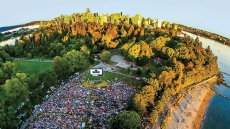Cycling is a great mode of transport that includes a lot of health and financial benefits.
Spring Bike to Work Week recently took place in Vancouver from May 29 to June 5, 2017. As per statistics presented by Hub Cycling, 11,128 registered riders and 1,730 first-time bike commuters took part in this initiative. The successful turnout of this event is only an indication that cycling can be a great mode of transport for work or pleasure. In fact, with summer on in full swing this is the ideal time to flaunt your bike, polish your cycling skills, and indulge in a cost-effective and healthy habit.
Making cycling your primary mode of transport has a lot of benefits. It is cost-effective, accessible, environment-friendly, and contributes greatly in boosting your health and mood. “A lot of trips between 3-10 km are quicker on bike than in a car or on transit as you don’t have to contend with congestion which also makes it less stressful,” asserts Ellie Lambert, director of communications at HUB Cycling, a charitable non-profit that aims to make cycling better through education, action and events.
Highlighting the cost-effective feature, maintenance of a bike is definitely cheaper than that of a car. “If you own a car you have to pay insurance, road tolls, parking costs, and gas but there are none of those costs when you are cycling, so it is one of the cheapest modes of transport out there,” comments Lambert adding that it is also cost-efficient as cycling infrastructure is cheap to build and lasts a long time.
Lambert points out that people on bikes save society money. For every kilometre ridden by a bike, society receives 21 cents back, due to the health benefits experienced by the rider and the reduced emissions and low price of building and maintaining facilities. “Compare this to cars, which cost society 23 cents per kilometre and it makes economic sense to invest in better biking,” she states, encouraging everyone to choose this environment-friendly option.
And let’s not forget the health advantages attached to this simple mode of transport. Besides providing you with your daily dose of exercise and physical activity, cycling is said to increase your mental health. “Cycling improves mental health as it’s not as stressful as being stuck in traffic and you get a lot more sunshine and fresh air,” says Lambert further mentioning a recent UK-based study that states people who cycle to work live longer as it lowers the risk of dying early by 40 per cent and the risk of developing cancer by 44 per cent.

Hub Cycling has been playing a crucial role in encouraging commuters to take up this practise and enjoy the many benefits cycling offers. Through events such as Bike to Work Week, Bike the Night, and Bike to Shop Days, the organization has been urging people to get on their bikes and travel around the city. “During these events we host celebration stations where people can grab refreshments, have their bikes checked by mechanics, and enter competitions, and we also giveaway prizes such as holidays and free bikes to incentivize people to take part,” adds Lambert. These events and incentives are motivating people to cycle to work on a daily basis. “Our surveys show that two thirds of people who start biking to work during Bike to Work Week are still cycling two months later,” reveals Lambert.
Through courses, in schools and local communities, Hub Cycling educates people to become safe and confident riders. “These [courses] make it a lot easier for new riders to start cycling,” says Lambert, who strongly advices cyclists to follow road rules. “People on bikes are vulnerable road users as we don’t have a big metal shell around us to protect us in the ways that cars do but as long as you take your time, be aware of other traffic around you and follow the rules of the road, cycling is a safe way to get around.” The cycling-focussed non-profit also advocates for better biking infrastructure and advises on new projects to ensure that they meet the needs of cyclists.
Though an increasing number of people have switched to cycles for their daily commute, a lot more needs to be done in terms of providing facilities and safety for riders. Lambert states that cities can help by providing safe infrastructure such as protected bike lanes, separated paths and traffic calmed streets. “All of these features create safer routes that make people feel more comfortable and confident when cycling.”
Other suggestions for cities and businesses to encourage cyclists include secure bike parking or lots of bike racks, and showers in workplaces for people to freshen up. “Cities can also encourage cycling by funding education courses for people who haven’t ridden before or are nervous cyclists,” says Lambert.
This summer, make cycling to and fro your fitness goal and enjoy the many benefits it offers.
Planning to cycle to work? Three things you should know
Plan your route: if you are new to riding, start by riding on quiet neighbourhood streets and separated lanes to build confidence. Planning your route ahead of time can ensure you don't end up riding on streets you are uncomfortable on. Remember – you can always get off your bike and walk through areas when you are feeling nervous.
Bikes on transit: Many public transit systems in BC allow you to take your bike on busses and SkyTrains. Combining biking and taking transit is a great way to get started. Look up the transit system in your area to learn the guidelines.
As a cyclist you have the same rights and responsibilities on the road as other vehicles.

Safety tips for cyclists
Ride one meter away from parked cars at all times. Avoid the door zone – a common area for accidents.
Be aware of blind spots, especially when riding near large vehicles. If you can't see their eyes in the mirrors, they can't see you.
Be visible. Ride with a front white light and red rear light and reflector from dusk until dawn. Using your lights during the day can also increase your visibility to other road users.
Be predictable. This involves riding in a straight line when possible, and signalling before changing positions on the road. Avoid weaving in and out between parked cars, which makes it difficult for other road users to see you and anticipate your movements.
Taking the lane on narrow streets - if you feel there is not enough room for another vehicle to pass you safely, you can "take the lane" by riding closer to the centre of the lane.
Choosing the right bike
The best place to start when you are purchasing a bike is to go to a reputable shop where they will be able to advise you on the best bike for your needs and help ensure the seat and handlebars are right for your height. Many good shops sell second hand bikes at a reasonable price and all of these will have been serviced to ensure they are roadworthy.
When buying a bike the main things to consider are:
Where will you be riding? E.g. on the road, on hills/mountains, or on trails. A hybrid is a good sort of bike that will be suitable for cycling to work or the shops, as well as going on longer rides on off-road trails.
When buying a second-hand bike from sites such as Craigslist, you should always check that it has not been stolen; you can search it against Project 529's database of stolen bikes. When you are viewing the bike take it for a test ride and check the brakes, go through all of the gears and ensure the tires have no punctures and the tread is not worn. Once you have purchased it, take it to a bike store and get it serviced by a trained mechanic.
Make sure the bike is the right size for you. When you stand next to it the seat should be inline with your hip and when you are astride it you should be able to stand on tiptoe.





